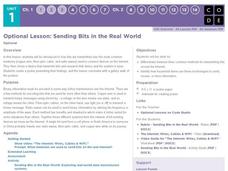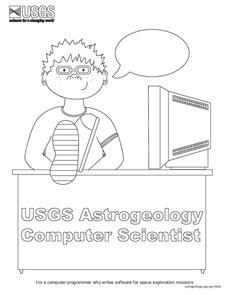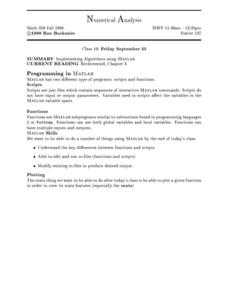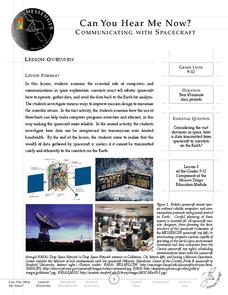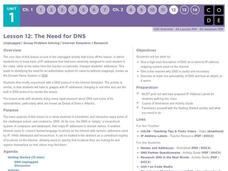Code.org
Sending Bits in the Real World
A bit optional. How do computers transmit in the real world? Pupils research a device that is used in transmitting bits, then individuals create a poster that presents the information they have learned about their device.
Society of Petroleum Engineers
Renewable and Nonrenewable Energy
Energize an environmental science unit on natural resources with this collection of instructional materials. From simple coloring sheets for primary grade children, to guiding questions for a high school research report, a wide variety...
Curated OER
USGS Astrogeology Computer Scientist
For this coloring worksheet, students will color a picture of a kid sitting with his feet up on a desk. The desk says, "USGS Astrogeology Computer Scientist." There is a description of the job title at the bottom of the page.
Curated OER
Numerical Analysis/ Introduction to Algorithms and Pseudocode
In this math worksheet, students examine the concepts of algorithms and pseudocodes. Then they use the codes on a computer to execute the algorithms.
Curated OER
Implementing Algorithms Using Matlab
In this math worksheet, students practice implementing algorithms using the computer program of Matlab. They practice using the programs of scripts and functions.
Curated OER
Computer Activity-The Sun
In this computer activity worksheet, students visit a website and take a Virtual Tour of the Sun. While navigating through the site, they complete 16 fill in the blank questions.
Curated OER
Chemistry Study Room
In this chemistry worksheet, students are offered a variety of assistance to help them be successful in organic chemistry. They will have access to the library, missed class notes and computer interactive programs to help them with...
Curated OER
Global Warming WebQuest-Climate Scientist
In this climate science activity, students answer five multi-part questions on the responsibilities of a climate scientist. Students may gain this knowledge through a WebQuest.
TryEngineering
Circuits and Boolean Expressions
Teach basic logic using Boolean operators. Young computer scientists learn about the operators NOT, AND, and OR, and how they can be expressed using Boolean notation, logic gates, or truth tables. Along the way, they learn about half...
Computer Science Unplugged
Twenty Guesses—Information Theory
How do we determine how much information to include and what can be left out? By playing a game of 20 questions, the class generates the best strategies for finding a number. They then move on to guessing the next letter in a short...
Messenger Education
Can You Hear Me Now?—Communicating with Spacecraft
Radio signals transmitted to Pluto take five hours to reach their destination! In these two activities, young scientists explore data communication in space. In activity one, pupils learn how data is gathered and sent back to Earth....
TryEngineering
Sorting Socks is Algorithm Complexity
Use hosiery to teach computer science. Scholars use socks to develop a set of algorithms. They find ways to find a particular sock from a set and ways to sort socks. Finally, they use their algorithms to consider time complexity.
Computer Science Unplugged
Colour by Numbers–Image Representation
How do computers store and send images? Here's an activity that explains one way a computer can compress image information. Pupils decode run-length coding to produce a black and white image. Pairs then work together to code and decode...
Curated OER
Earth Viewer Welcomes You- Web View of the Earth
For this science and Internet technology worksheet, students access the given web site to look at a current view of the Earth's surface. They enter longitude and latitude co-ordinates before answering 8 questions. They change the...
Curated OER
Cartoons for the Classroom: The Climate Change Debate
Is global warming all smoke and mirrors? Find out what your scholars think with this handout, which has them analyzing two political cartoons on the topic. Background information gives context, detailing the computer hacking during the...
Curated OER
It's too loud!
Investigate soft, loud, and dangerous sounds. Little ones put a check next to the sounds that are loud, an X next to ones that are soft, and circle the ones that would require protective ear wear. Tip: Get out a tape player or computer...
University of California
Hot! Hot! Hot!
Calories are not tiny creatures that sew your clothes tighter every night, but what are they? A science activity, presented at multiple levels, has learners experiment with heat, heat transfer, and graph the function over time. It also...
Curated OER
English Exercises: The Significance of Science in Society
In this significance of science in society worksheet, 8th graders read 3 paragraphs, then interactively answer 9 comprehension and grammar questions, with immediate online feedback; video at the beginning is not longer available, but the...
Curated OER
A simple computer
In this circuit instructional activity, students build a circuit simulating a simple computer using light bulbs, breadboards, push pins and more. Students then complete a chart and answer 1 question.
Curated OER
Energy Crossword
In this science worksheet, students solve the crossword puzzle using the context of energy to acquire a new understanding of vocabulary words.
Curated OER
Curious Science: Magnetism
In this online interactive science worksheet, students respond to 3 multiple choice questions about magnetism and its functions.
Code.org
The Need for DNS
That's one complicated address book! To understand the need for a system that keeps track of addresses, pupils trying to find the IP address of their classmates. Then individuals change their IP addresses, which leads to research about...
Curated OER
The Science Behind Glow-in-the-Dark Toys
In this glow-in-the-dark worksheet, learners read about substances that phosphor and their characteristics. Students also read about photo luminescence and glow-in-the-dark toys. They answer 6 questions about the light emitted by...
Curated OER
Integrating Environmental Science: Plastics
In this plastics worksheet, students read about the uses of plastics and their environmental impact. Students answer questions about plastics and their use.


